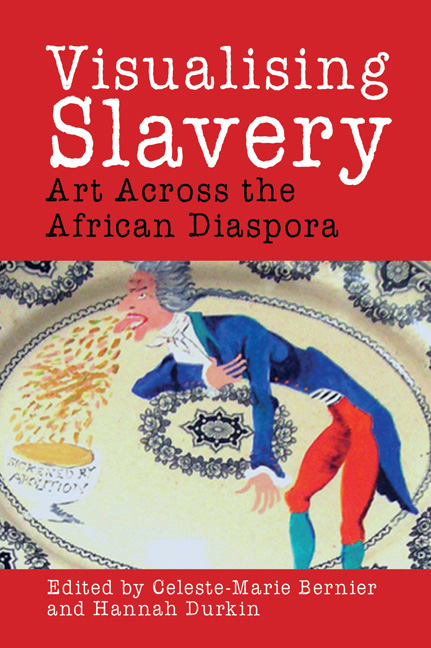Book contents
- Frontmatter
- Dedication
- Contents
- List of Illustrations
- Acknowledgements
- Introduction: ‘Inside the Invisible’: African Diasporic Artists Visualise Transatlantic Slavery
- Part I Slavery and Memory in Contemporary African Diasporic Art
- Part II Historical Iconography and Visualising Transatlantic Slavery
- Part III African Diasporic Monuments and Memorialisation
- Part IV Contemporary Legacies in African Diasporic Art
- Afterword: Against the Grain: Contingency and Found Objects
- Notes on Contributors
- Index
- Platesection
Introduction: ‘Inside the Invisible’: African Diasporic Artists Visualise Transatlantic Slavery
- Frontmatter
- Dedication
- Contents
- List of Illustrations
- Acknowledgements
- Introduction: ‘Inside the Invisible’: African Diasporic Artists Visualise Transatlantic Slavery
- Part I Slavery and Memory in Contemporary African Diasporic Art
- Part II Historical Iconography and Visualising Transatlantic Slavery
- Part III African Diasporic Monuments and Memorialisation
- Part IV Contemporary Legacies in African Diasporic Art
- Afterword: Against the Grain: Contingency and Found Objects
- Notes on Contributors
- Index
- Platesection
Summary
‘Swallow Hard: The Lancaster Dinner Service is an intervention, a mapping and an excavation. It is a fragile monument to an invisible engine working for nothing in an amazingly greedy machine. It remembers slave servants, sugary food, mahogany furniture, greedy families, tobacco and cotton fabrics but then mixes them with British wild flowers, elegant architecture and African patterns’. So Black British artist Lubaina Himid summarises her mixed-media installation consisting of a 100-dinner piece service and exhibited at the Judges’ Lodgings, Lancaster, UK in 2007. An especially hard-hitting work in her self-reflexively experimental and politically unflinching series is Vomiting Toff, a plate which appears on the front cover of this book and in which Himid cuts to the heart of the hypocrisies, paradoxes and failures inscribed in historical and contemporary national commemorations of the abolition of the slave trade in particular and of transatlantic slavery more generally. As shown here, Himid's lavishly dressed and grotesquely caricatural eighteenth-century white male figure vomits yellow debris – symbolically suggestive not only of shackles but of monetary currency in gold coins – directly above her satirical caption, which reads, ‘SICKENED BY ABOLITION’. For ‘SICKENED BY ABOLITION’ read ‘SICKENED BY SLAVERY’ as Himid's Swallow Hard: The Lancaster Dinner Service constitutes a radically revisionist ‘intervention’, ‘mapping’ and ‘excavation’ in which she substitutes official commemorations of white abolitionism with stark memorials bearing witness to the missing bodies and souls no less than the histories, narratives and memories of untold and unseen enslaved millions living unrepresented lives within the centuries-long institution of transatlantic slavery.
More revealingly still, and coming to life in subversive relation to Vomiting Toff, Himid includes a series of jugs and tureens on which she provides close-up portraits of the unreadable physiognomies of unidentified Black female and male subjects as they appear in individually dressed ‘African patterned’ clothing, directly confronting the viewer. Notably, and as Himid herself confides, ‘no black faces’ appear on any plates included in this installation, a deliberate protective measure to ensure ‘that we are never covering them with food or the smears of leftovers’.
- Type
- Chapter
- Information
- Visualising SlaveryArt Across the African Diaspora, pp. 1 - 14Publisher: Liverpool University PressPrint publication year: 2016

